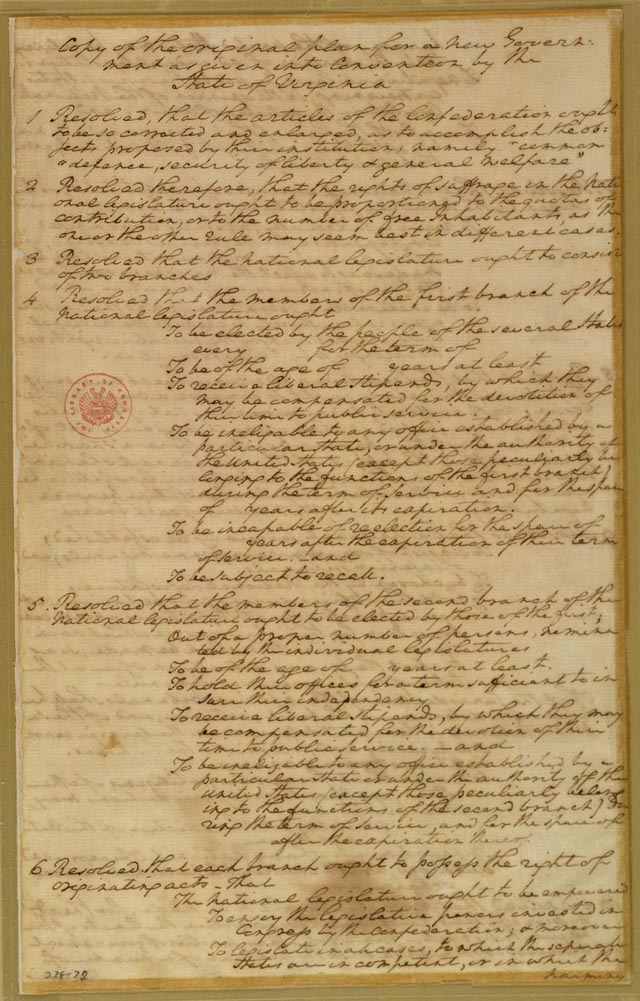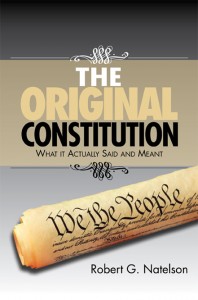The inadequacy of the Articles of Confederation as a governing charter induced the delegates at the federal convention to look for other models. The perils of extreme decentralization, coupled with the understandable influence of British precedents, help explain why the first instinct of convention leaders was to propose a “consolidated” rather than a “federal” union.
This consolidationist vision was embodied in the Virginia Plan, socalled because it was proposed by the Virginia delegation, led de facto by Governor Edmund Randolph and by James Madison. In effect, the Virginia Plan was a scheme in which the states would survive only as “corporations,” fulfilling the kind of subordinate roles that local government played in England. One delegate, Delaware’s George Read, proposed abolishing the states entirely.’ Most of the delegates believed, however, that the states should be preserved, if merely for instrumental reasons: The general government simply could not “extend Its care to every requisite object'” over such a large temtory.
The Virginia Plan served as the basis of discussion during the first few weeks of the convention. The Virginia Plan was premised on the conclusion that the Articles were inadequate to “accomplish the objects proposed by their institution; namely, ‘common defence, security of liberty and general welfare.”
By the terms of the scheme, the new government would receive the cumulative total of powers (1) that Congress had enjoyed under the Confederation, (2) in which “the separate states are incompetent,” and (3) necessary to “the harmony of the United States… In addition, Congress would receive (4) a plenary veto over state legislation. At this stage, proposals for a more limited list of federal powers were dismissed as impractical. When the New Jersey delegation offered its own, more decentralized proposal on June 16, 1787 (the New Jersey Plan) the delegates rejected it by a decisive vote.
On the other hand, they quietly laid aside the proposal of Alexander Hamilton, offered on June 18, which would have granted Congress legislative authority without limit-“with power to pass all laws whatsoever”-subject only to the executive veto. While not going quite as far as Hamilton, the delegates at this point still appeared willing to grant the new government even the power to interfere with the “internal police” (internal governance) of states. Indeed, when Roger Sherman proposed that the states retain exclusive jurisdiction over such matters, Gouverneur Morris responded that in some cases they ought not even have that.
Sherman introduced his proposal in the form of a motion to enumerate the powers of the central government, with a proviso that states should be able to legislate when “the General welfare of the United States is not concerned’ The convention rejected it, adopting instead a resolution allowing Congress “to legislate in all cases for the general interests of the Union, and also in those to which the States are separately incompetent, or in which the harmony of the United States may be interrupted by the exercise of individual legislation.”
Yet the day the convention rejected Sherman’s motion-July 17, 1787-marked the high tide of proposed centralization. He was only one of several delegates contending that the states should not be mere “corporations,” but should be left with considerable authority. Later the same day they won their first battle when the convention voted to abandon the congressional veto over state legislation and to replace it with a general supremacy clause. On July 23, when the draft constitution was submitted to the Committee of Detail, the new government was not yet limited to enumerated powers, but when the Committee submitted its revision on August 1, the sweeping language of the Virginia Plan was gone and a modest enumeration had replaced it. Efforts later in the convention to add powers to the list were mostly unsuccessful.
Meanwhile, the process had begun of tacking general welfare language onto the new government’s financial powers. On August 6, the Committee of Detail presented to the convention a draft constitution embodying the delegates’ agreements thus far. The draft did not include a general welfare qualification on federal tax authority, so Dickinson added the following words on his copy: “no Preference or Advantage to be given to any persons or places-Laws to be equal..” Soon thereafter, Dickinson was placed on a Committee of Eleven chaired by William Livingston to deal further with financial issues. On August 21, that committee proposed a general welfare qualification to the payment of debts. On August 25, Roger Sherman offered a proposal to connect the previously-granted power to pay Confederation debts with the Taxation Clause, qualifying them both with general welfare language. Madison reported:
Mr. Sherman thought it necessary to connect with the clause for laying taxes duties &c [sic] an express provision for the object of the old debts &c-and moved to add to the Ist. clause of 1st. sect—of art VII “for the payment of said debts and for the defraying the expences that shall be incurred for the common defence and general welfare”
The proposition, as being unnecessary was disagreed to, Connecticut alone, being in the affirmative.
However, just as Roger Sherman initially lost on enumerating federal powers only to win via committee, here he also recovered to win via committee. On September 4, a Committee of Eleven, headed by Judge David Brearley-and also numbering among its members John Dickinson recommended insertion in the Taxation Clause the phrase “to pay the debts and provide for the common defence and general welfare.” Historian Charles Warren argues that this was but a replacement for Sherman’s earlier wording, “for the payment of said debts and for the defraying the expences that shall be incurred for the common defence and general welfare..” Again, we see the future~ orientation of the reference to spending.
A more recent historian, Forrest McDonald, contends that “[t]he phraseology … was understood as prohibiting the expenditure of money for such ‘internal improvements’ as roads and canals, since those must, of necessity, promote the particular welfare of specific states rather than the ‘general’ welfare…” Both of these seem consistent with Dickinson’s apparent reason for the Clause: that “no Preference or Advantage to be given to any persons or places.”
Thus, the Taxation Clause now read, “[t]he Legislature shall have power to lay and collect taxes, duties, imposts, and excises, to pay the debts and provide for the common defence and general welfare of the United States…” A Committee of Style and Arrangement chaired by Gouverneur Morris later added a requirement that indirect taxes be uniform. Finally, on September 12 and 13, Dickinson cooperated with George Mason to insert in the Constitution a Congressional power to revise state inspection duties. The idea was to prevent states with ports from oppressing those without–consistent with Dickinson’s consistently-stated view.
Regarding Gouverneur Morris, a stubborn tradition has it that he thought that the General Welfare Clause was a separate and copious fount of legislative power. The basis for this tradition rests on the convention notes of James McHenry for September 6:
Spoke to Gov Morris Fitzimmons and Mr Goram to insert a power in the confederation enabling the legislature to erect piers for protection of shipping in winter and to preserve the navigation of harbours-Mr Gohram against. The other two gentlemen for it-Mr Gov: thinks it may be done under the words of the I clause I sect 7 art. amended” and provide for the common defence and general welfare.[“]-If this comprehends such a power, it goes to authorise the legis!. to grant exclusive privileges to trading companies etc.
McHenry apparently understood Morris’s point to be that the General Welfare Clause was plenary in nature because it could serve as a source of authority to erect piers and therefore create monopolies. McHenry was likely confused. He tells us that Morris and Thomas Fitzsimmons were in favor of “insert[ing] a power . . . enabling the legislature to erect piers.” If Morris was in favor of inserting such a power, he could not have thought the General Welfare Clause broad enough to include it. Morris’ suggestion that “it may be done under the words … ‘and provide for the common defence and general welfare”, may mean only that the insertion could be placed in the part of the enumeration that follows (i.e., is physically “under”) the Taxation Clause.
Gouverneur Morris plays the villain in another doubtful story. This is the tale that, as chairman of the Committee of Style and Arrangement he surreptitiously tried to create an independent general welfare power by setting off the General Welfare Clause from the language immediately preceding with a semicolon rather than a comma. The tale was told more than a decade later by Albert Gallatin on the floor of Congress.
This story also seems unlikely, and Gallatin could not have known the truth personally since he wasn’t at the convention. The story assumes that Morris thought he was playing with fools, easily hoodwinked-at the Philadelphia convention, the “assembly of demigods!” Of course, any sleight of hand was likely to be caught, and this error was indeed caught. The convention’s decision to remove the semicolon corroborates the conclusion that the General Welfare Clause was not an independent power.
EDITOR’S NOTE: This article is an excerpt from Professor Natelson’s paper, The General Welfare Clause and the Public Trust: An Essay in Original Understanding, published in The Kansas Law Review (Vol. 52, p. 1, 2003). The paper examines the original understanding behind the U.S. Constitution’s controversial “General Welfare Clause.” Based on Founding-Era word usage, public representations by advocates of the Constitution, and other historical evidence, the paper concludes that the General Welfare Clause is a limitation on the taxing power. The position of the modern Supreme Court — that the Clause authorizes spending for the general welfare — is based on insufficient research and an anachronistic understanding of language. CLICK HERE FULL THE FULL PAPER (.pdf)

- Insights into the Constitution from English Social History - October 7, 2024
- More Evidence that “Direct Taxes” include Levies on Wealth and Income - July 26, 2024
- Clearing Up the Confusion About the Constitution’s Term “Direct Taxes” - July 17, 2024

